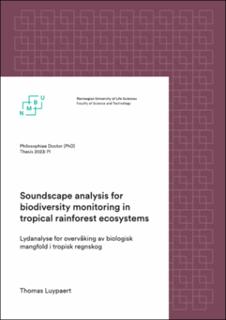| dc.description.abstract | Tropical rainforests harbour up to 66% of the world’s terrestrial biodiversity but have been reduced in extent by up to 60% due to persistent deforestation and forest degradation, resulting in the population decline or loss of ecologically and socioeconomically important wildlife species. In recognition of the biodiversity crisis as an actor of global change, several international initiatives, including the Convention of Biological Diversity and its ‘Aichi Biodiversity Targets for 2020’, have been implemented to curb biodiversity loss. Here, the collection of primary data that provide an objective record of community-level biodiversity is crucial to understanding fundamental ecological processes, the trends and drivers of change, and the progress made towards conservation targets. Yet, the rapid and global nature of the biodiversity crisis means that monitoring biodiversity at appropriate spatio-temporal scales is riddled with difficulties. Passive Acoustic Monitoring (PAM) yields promising perspectives, such as increased taxonomic breadth and the potential for automation. Still, deriving taxonomic information from acoustic data is complicated by the time-consuming nature or aural annotation and the lack of existing automated species identifiers and reference databases. Ecoacoustic is a new field of research that instead is aimed at inferring ecological information from the soundscape – or collection of sounds emanating from the landscape – without the need for species identification. Here, mathematical formulae called acoustic indices are used to summarise the diversity of acoustic signals in sound files and link values to diversity patterns. Although this discipline has made substantial progress towards becoming a useful monitoring tool, the ability of acoustic indices to reflect biodiversity trends or ecological patterns must be validated before this technology is implemented on a global scale. Several limitations and research opportunities remain to be addressed and will be the focus of this thesis.
This thesis presents a novel analytical workflow that combines ecoacoustic methods with the analytical framework of Hill numbers, resulting in a comprehensive set of intuitive acoustic indices for measuring soundscape diversity patterns at multiple scales. Chapter I introduces the analytical approach, confirming that the derived acoustic indices adhere to essential criteria for diversity indices, while also evaluating their effectiveness in capturing richness patterns of sound-producing species in tropical rainforests. In Chapter II, the investigation delves deeper into the spatial variations of soundscape richness within a highly insularised rainforest system, revealing a positive correlation between island size and soundscape richness across multiple scales, and linking the observed patterns to underlying ecological mechanisms. Chapter III introduces soundscapeR, a user-friendly software tool implemented in the R coding language, facilitating the use of the workflow. Collectively, these chapters demonstrate the potential of this new approach, presenting a valuable addition to the ecoacoustic monitoring toolbox that can be used to shed light on ecological mechanisms and their drivers in acoustically complex rainforest settings. | en_US |

